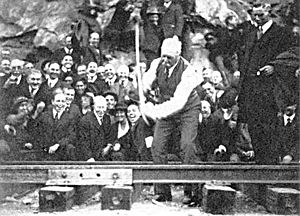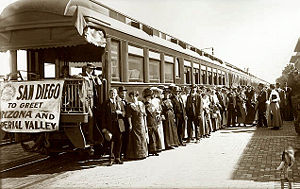San Diego and Arizona Railway
2008/9 Schools Wikipedia Selection. Related subjects: Railway transport
| San Diego and Arizona Railway | |
|---|---|
 |
|
| Reporting marks | SDA |
| Locale | California and Mexico |
| Dates of operation | 1919–1932 |
| Track gauge | 4 ft 8½ in (1,435 mm) ( standard gauge) |
| Headquarters | San Diego, California |
The San Diego and Arizona Railway was a short line American railroad ( AAR reporting marks SDA) founded by "sugar heir," developer, and entrepreneur John D. Spreckels, and dubbed "The Impossible Railroad" by many engineers of its day due to the immense logistical challenges involved. Established in part to provide San Diego with a direct transcontinetal rail link to the east by connecting with the Southern Pacific Railroad (which secretly provided the funding for the endeavor) lines in El Centro, California, the 148- mile (238- kilometer) route of the SD&A originated in San Diego, California and terminated in the Imperial County town of Calexico.
The company charter was executed on December 14, 1906, and the groundbreaking ceremony was held on the following September. Numerous delays (including government intervention during World War I) delayed the completion of the line to November 15, 1919. Damage to the lines from both natural disasters and sabotage exerted great financial pressure on the company, and in 1932 Spreckels' heirs sold their interests in the railroad to the Southern Pacific, which was theafter named the San Diego and Arizona Eastern Railway (SD&AE).
History
The company was chartered on December 14, 1906, and groundbreaking ceremonies held at the intersection of San Diego's Main and 26th Streets on September 7, 1907. Construction delays, attacks by Mexican revolutionaries, and government intervention during World War I all served to push the construction completion to November 15, 1919 when the "golden spike" was finally driven by none other than John Spreckels himself.
The first through SD&A passenger train left Campo on the morning of December 30, and made the full run from El Centro to San Diego's downtown Union Station for the official opening of the line on December 1, 1919. The total construction cost of the 146.4 miles of track laid was approximately $18 million, or some $123,000 per mile; the original estimate was $6 million. The 11-mile long segment through Carriso Gorge (which included 13,385 feet of tunnels, 17 in all) alone cost over $4 million to construct; the three miles of tunnels (21 total) along the entire line ran another $1.8 million. Almost 2.5 miles of bridges and trestles were built as well.
The tracks departed downtown San Diego south where they crossed the U.S.-Mexico border at San Ysidro. From there the line traversed eastward through Tijuana, then headed northeast through Tecate and back over the border to the town of Campo. To construct and maintain the 44-mile (72 kilometer) stretch through Mexico the SD&A formed the Ferrocarril Tijuana y Tecate, S.A. de C.V., at the behest of the Mexican government. East of Campo the road traveled through Clover Flats, across the Coast Range (elevation 3,660 feet), then descended through the breathtaking but treacherous Carriso Gorge, the builders' most significant obstacle. Though the SD&A line ended in Seeley, trackage rights gave the railroad the ability to run trains as far east as El Centro and as far south as Calexico. Branch lines ran from downtown to as far north and east as the community of Lakeside, with a separate line which circumvented San Diego Bay to service Coronado Heights, Coronado, and North Island.
Damage to the lines from heavy rainstorms, landslides, and fires took a financial toll on the railroad, as did border closings with Mexico. Clashes with the IWW resulted in acts of vandalism as well. In 1932, financial difficulties forced Spreckels' heirs to sell their interests in the firm for $2.8 million to the Southern Pacific, which renamed the railroad the San Diego and Arizona Eastern Railway (SD&AE).
Timeline
- 1873: The Texas and Pacific Railroad fails in an attempt to estabish a direct rail link between San Diego and the East during the " Panic of 1873."
- 1905: The San Diego and Eastern Railroad (SD&E) conducts a survey for a planned rail line to Arizona but folds prior to commencing track laying.
- December 14, 1906: John D. Spreckels announces he will form the San Diego and Arizona Railway Company (SD&A) and build a 148-mile line between San Diego and El Centro. Spreckels has an agreement with the Southern Pacific Railroad (SP) to silently fund the project (ironically, Spreckels later became an outspoken critic of the Southern Pacific Railroad and their monopolistic practices, and often used his newspaper interests as a platform to denounce the company and its officers).
- September 7, 1907: Groundbreaking ceremonies for the SD&A are held in downtown San Diego at the foot of 26th Street (now known as Dewey Street) and Main Street. The line will follow in part the route surveyed by the defunct SD&E.
- 1909: The Mexican Government orders the SD&A to form the Tijuana and Tecate Railway Company, which will construct and hold a 99-year lease on the 44-mile Mexican rail segment.
- July 29, 1910: The first passenger train on the SD&A enters Mexico.
- 1911: Mexican revolutionaries mount several attacks on the SD&A construction crews to conscript soldiers and supplies, and cut telephone wires.
- 1916: The "Great Flood" washes out several rail lines. World War I increases the cost of railway construction materials by 50 to 150 percent.
- 1917: The U.S. federal government seizes control of all railroads and stops construction of the SD&A as part of its war effort to conserve resources, but later grants Spreckels special exemption on the grounds the SD&A will serve a military installation. The SD&A absorbs the struggling San Diego and Southeastern Railway (SDSR), assuming operation of the company's steam divisions and gas-electric motor cars. The San Diego Electric Railway (SDERy) continues to operate the interurban line to Chula Vista under lease. The remaining SDSR tracks not damaged in the previous year's flooding function as a "bridge" line between the SD&A and SDERy, which allows for the interchange of freight traffic.
- November 15, 1919: The "golden spike" is driven and construction of the SD&A is completed at a cost of $18 million (three times the original estimate).
- December 1, 1919: The first passenger train "arrives" in San Diego from El Centro for the official line opening ceremony.
- December 10, 1919: Through Pullman service to Chicago is initiated; the cars are switched to the Southern Pacific's Golden State passenger train in Yuma.
- 1922: A new emblem, depicting a scene in the Carrizo Gorge and lettered "San Diego Short Line," is adopted.
- 1926, 1927, and 1929: Heavy rains take out large sections of trackage east of San Diego.
- 1928: Motor service to La Mesa and Lakeside is discontinued.
- January 1932: Fire breaks out in Tunnel 3 in Baja California, which leads to a collapse. Repairs take 45 days.
- March 27, 1932: A huge mountain slide, loosened by heavy rains, blocks the line in the vicinity of Tunnel 15. Repairs are completed and freight and passenger services are re-established on July 6 and 7th.
- October 22, 1932: Tunnel 7 burns and is subsequently abandoned.
- October 24, 1932: Financial problems force Spreckels' heirs to transfer their share of SD&A ownership to the Southern Pacific Transportation Company for $2.8 million.
- January 23, 1933: A bypass track along the cliff at Tunnel 7 is completed and the line is reopened to traffic.
- February 1, 1933: The San Diego and Arizona Eastern Railway (SD&AE) is incorporated and assumes all operations of the SD&A.


